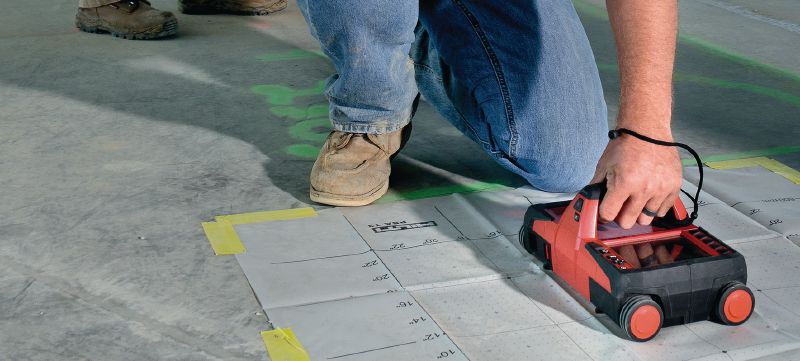RainierGPR Concrete Scanning: Advanced Solutions for Safe Construction
RainierGPR Concrete Scanning: Advanced Solutions for Safe Construction
Blog Article
Exploring the Secret Advantages of Concrete Scanning in Building And Construction Projects
In the realm of contemporary building and construction methods, the utilization of concrete scanning innovation has arised as a crucial tool for ensuring task performance and structural integrity. From boosting safety and security measures to precisely detecting energies hidden underneath the surface area, the benefits of concrete scanning are multifaceted. RainierGPR Concrete Scanning.
Improved Precaution
Making use of innovative concrete scanning modern technology improves safety and security procedures on building and construction websites by supplying accurate discovery of prospective threats hidden beneath the surface area. This innovation makes it possible for construction teams to identify rebar, conduits, post-tension wires, and various other obstructions before excavation or boring, dramatically decreasing the threat of crashes. By identifying these elements precisely, employees can prevent destructive important structural elements, thus preventing injuries, delays, and costly repair work.
Additionally, concrete scanning plays an important role in making sure the honesty of existing frameworks during growths or improvements. By detecting weak points, spaces, or deterioration within concrete aspects, engineers can deal with these concerns proactively, boosting the general security and longevity of the structure. This proactive approach not only reduces the risk of architectural failings yet also minimizes the possibility for crashes triggered by unpredicted structural shortages.
In essence, the application of concrete scanning technology works as a proactive safety step that safeguards both building and construction workers and the structural honesty of buildings, ultimately contributing to the total success and effectiveness of building and construction jobs. - RainierGPR Concrete Scanning
Accurate Detection of Utilities
Concrete scanning modern technology promotes exact identification of underground utilities, boosting building website safety and security and efficiency. Accurate discovery of utilities is critical in building and construction projects to avoid expensive damages, job delays, and most significantly, make sure the safety and security of employees and the public. By using sophisticated scanning innovations such as ground-penetrating radar (GPR) and electro-magnetic induction, construction teams can draw up the place of buried pipes, cords, and various other utilities with high levels of precision.

Time and Price Performance

Concrete scanning innovation allows construction teams to accurately find rebar, post-tension wires, and various other ingrained objects within concrete structures. This specific information aids in avoiding expensive blunders such as unintentional damages to important aspects during drilling, Web Site cutting, or coring activities. Additionally, by recognizing prospective dangers beforehand, the need for costly repair work or rework as a result of damages can be reduced, resulting in cost financial savings for the project.

Furthermore, the ability to promptly and accurately detect energies beneath the surface without creating any type of damage not just saves time yet likewise stops expensive disruptions to existing facilities. In general, the time and expense effectiveness advantages of concrete scanning make it a vital tool for boosting building and construction task administration and implementation.
Preservation of Structural Integrity
Preserving the architectural integrity of buildings and framework is vital in making certain long-term stability and safety and security. Concrete scanning plays a crucial duty in this preservation procedure by allowing building specialists to determine potential risks to the structural integrity of a structure or infrastructure before they intensify into significant problems. With using sophisticated scanning technologies such as ground-penetrating radar (GPR) and electromagnetic induction, building teams can non-invasively examine the condition of concrete frameworks, find look these up rebar, post-tension cable televisions, and other embedded aspects, and recognize any type of gaps, cracks, or damage within the concrete.
Improved Task Planning
In order to ensure the successful implementation of building tasks, careful interest to information and extensive planning are crucial components that originate from an extensive understanding of the architectural conditions identified via concrete scanning. Improved job preparation, promoted by concrete scanning, permits building and construction teams to preemptively deal with possible obstacles, allot resources a lot more effectively, and establish sensible timelines. By accurately identifying the area of rebar, post-tension wires, and various other ingrained items within concrete frameworks, job supervisors can develop extra specific building plans that minimize the risk of costly mistakes or hold-ups. In addition, the data gotten from concrete scanning enables stakeholders to make informed decisions relating to architectural adjustments, renovations, or developments, causing smoother project transitions and enhanced total task results. Inevitably, including concrete scanning into the task planning phase improves sychronisation amongst staff member, promotes aggressive analytical, and adds to the effective shipment of construction tasks within spending plan and routine restraints.
Conclusion
In verdict, concrete scanning uses countless benefits in building jobs. By enhancing safety and security measures, properly spotting energies, improving time and expense performance, maintaining structural integrity, and helping in project preparation, concrete scanning shows to be an important device for effective task implementation. Its capacity to reduce threats, boost efficiency, and make certain project integrity makes it an important property for building experts.
In the realm of modern-day building and construction techniques, the usage of concrete scanning innovation has actually arised as a critical device for ensuring project performance and structural integrity.Concrete scanning technology enables building and construction teams to accurately locate rebar, post-tension cords, and other ingrained objects within concrete frameworks. Through the usage of sophisticated scanning modern technologies such as ground-penetrating radar (GPR) and electro-magnetic induction, building groups can non-invasively evaluate the problem of concrete frameworks, locate rebar, post-tension cable televisions, and other embedded elements, and recognize any kind of spaces, splits, or deterioration within the concrete.
In order to guarantee the effective execution of building and construction projects, thorough focus to information and complete planning are vital elements that stem from an extensive understanding of the structural problems determined via concrete scanning. Inevitably, including concrete scanning into the job preparation phase boosts control amongst group members, promotes aggressive analytic, and contributes to the successful distribution of building and construction tasks within budget useful content and schedule constraints.
Report this page